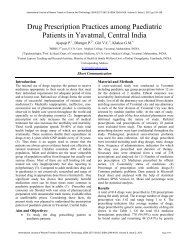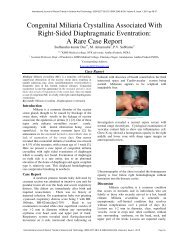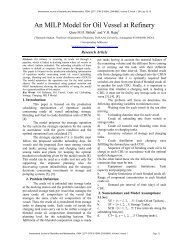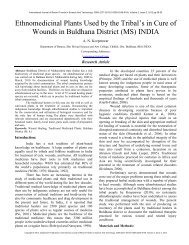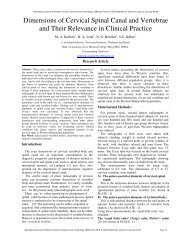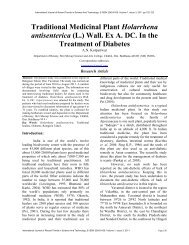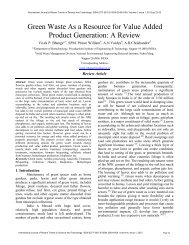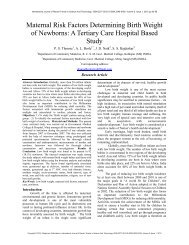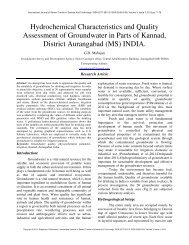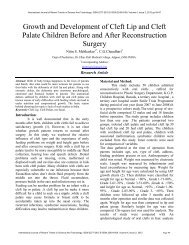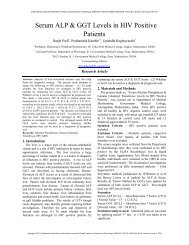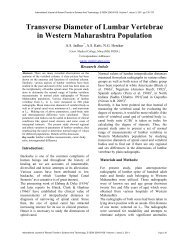A Case Report - Statperson
A Case Report - Statperson
A Case Report - Statperson
Create successful ePaper yourself
Turn your PDF publications into a flip-book with our unique Google optimized e-Paper software.
International Journal of Recent Trends in Science And Technology, ISSN 2277-2812 E-ISSN 2249-8109, Volume 7, Issue 1, 2013 pp 22-23<br />
Isolated Agenesis of Epididymis in Cryptorchidism<br />
- A <strong>Case</strong> <strong>Report</strong><br />
Dhiraj Parihar 1 , Preeti raikwar 2 , Arvinder Pal Singh Batra 3* , Jeewandeep Kaur 4 , Gaurav Thami 5 , Karamvir 6<br />
{ 1, 5 Assistant Professor, Department of Surgery} { 2 Assistant Professor, Department of Pediatrics}<br />
{ 3 Professor & Head, Department of Anatomy}, { 4 Assistant Professor, Department of Physiology}<br />
{ 6 Senior Medical Officer, Department of Anesthesiology}<br />
BPS, Government Medical College for women, Khanpur Kalan, Sonepat, Haryana, INDIA.<br />
Abstract: Undescended testis frequently associated with<br />
epididymal malformation, range from simple epididymal<br />
elongation to more complex forms, such as complete disruption<br />
between the testis and epididymis. The cause of cryptorchidism is<br />
multifactorial, although possible causes and risk factors, such as<br />
endocrine disorders, anatomical abnormalities and environmental<br />
and genetic factors, can explain the etiology of this phenomenon.<br />
Epididymal abnormalities may associated with severe impairment<br />
in sperm maturation and hindered transportation, with the future<br />
intrascrotal or extra scrotal position of the testis or early surgical<br />
repair being of little importance in terms of fertility. Our case<br />
suggests that blind ended vas may be associated with testis so one<br />
should search end of spermatic vessels if encountered with blind<br />
ended vas.<br />
Key words: Undescended testis, epididymal malformation,<br />
xenobiotics.<br />
Introduction<br />
Undescended testis frequently associated with<br />
epididymal malformation, range from simple epididymal<br />
elongation to more complex forms, such as complete<br />
disruption between the testis and epididymis (Koff,<br />
1990). This classification based on the relation between<br />
testis and epididymia, the length of epididymis and the<br />
configuration of epididymis. But Marshall and Shermeta,<br />
1979 divided this anomaly into 3 groups, including<br />
agenesis of the epididymis, atresia of the epididymis and<br />
loop or elongated epididymis. This association explained<br />
by hypothesis that development of epididymis &<br />
obliteration of process vaginalis need common stimulus<br />
(Han and Kang 2002).<br />
<strong>Case</strong> report<br />
In the present case of 3 years old male child<br />
brought to surgical OPD at BPS GMC for Women,<br />
Khanpur Kalan, Sonepat, Haryana by his father with<br />
history of absent of right testis since birth. On<br />
examination right sided testis was non palpable. On<br />
Ultrasound study right testis illustrated in right inguinal<br />
canal with no other obvious abnormality in abdomen.<br />
* Corresponding Address:<br />
apsbatra@yahoo.com<br />
<strong>Case</strong> <strong>Report</strong><br />
After routine investigation inguinal exploration was done.<br />
Per operatively (Fig: I) testis was located at deep inguinal<br />
ring with size of 11 x 18 mm and epididymis could not be<br />
appreciated and vas had course away from spermatic<br />
vessels and blind ended. Testis could be easily mobilized<br />
in scrotum and placed in subdartous pouch.<br />
Fig 1: Illustrate the blind ended Vas with course away from the<br />
testicular vessels and absence of epididymis<br />
Discussion<br />
The epididymis, located between the efferent<br />
ducts and the vas deferens, is a male accessory organ<br />
characterized by a single coiled tubule duct with an<br />
estimated length of 5–7 m in men (Sullivan, 2004;<br />
O’Hara et al., 2011). The testis and the caput epididymis<br />
arise from the genital ridge, whereas the body of the<br />
epididymis and vas deferens are derived from the<br />
mesonephric tubules and the wolffian duct respectively.<br />
Union by canalization of the rete testis and mesonephric<br />
tubules begins at 12 weeks and probably is completed at<br />
puberty (Cromie, 1978). Han and Kang, 2002 reported<br />
61% incidence of abnormal epididymis in undescended<br />
testis. Out of that most common anomaly was incomplete<br />
attachment of the caput epididymis, followed by<br />
detachment of caput and cauda epididymis. He also<br />
observed epididymal anomalies were strongly associated<br />
International Journal of Recent Trends in Science And Technology, ISSN 2277-2812 E-ISSN 2249-8109, Volume 7, Issue 1, 2013 Page 22
Dhiraj Parihar, Preeti raikwar, Arvinder Pal Singh Batra, Jeewandeep Kaur, Gaurav Thami, Karamvir<br />
with the patency of the processus vaginalis irrespective of<br />
testicular descent. He hypothesed that a common<br />
stimulus, possibly androgens, may be required for the<br />
epididymal development and obliteration of the processus<br />
vaginalis. The cause of cryptorchidism is multifactorial,<br />
although possible causes and risk factors, such as<br />
endocrine disorders, anatomical abnormalities and<br />
environmental and genetic factors, can explain the<br />
etiology (Nieschalag et al., 2000). The development and<br />
maintenance of the epididymis depends on androgens.<br />
Through the influence of lifestyle, environmental factors<br />
or prenatal exposures to compounds, xenobiotics<br />
(substances that are foreign to an organism but can<br />
produce adverse effects or damage under specific<br />
conditions of use) can act as endocrine disruptors that<br />
reduce testosterone synthesis and androgenic signaling.<br />
The epididymis is therefore a potential target for the toxic<br />
effects of xenobiotics, which may then influence male<br />
fertility (Smithwick and Young, 2001; Marty et al.,<br />
2003). Blind ended vas usually seen in testicular<br />
vanishing syndrome (testes vanished at some point<br />
following induction of masculinization, possibly as a<br />
result of an intrauterine vascular accident or testicular<br />
torsion) gave us the signal to terminate the exploration<br />
when we found absent testis with a blind-ending vas plus<br />
vessels on one or both side in an operation for impalpable<br />
testis (Lou, 1994). Our case suggests that blind ended vas<br />
may be associated with testis so one should search end of<br />
spermatic vessels if encountered with blind ended vas.<br />
Summary<br />
The possibility of epididymal anomaly should<br />
be considered in case of cryptorchidism. Status of<br />
epididymis should not be overlook by surgeon during<br />
orchidopexy. Early successful orchidopexy alone may not<br />
ensure subsequent fertility despite the presence of normal<br />
germ cells.<br />
References<br />
1. Cromie WJ (1978). Congenital anomalies of the testis,<br />
vas, epididymis, and inguinal canal. Urol Clin N Am ; 5:<br />
237-5.2<br />
2. Han CH, Kang SH (2002): Epididymal Anomalies<br />
Associated with Patent Processus Vaginalis in Hydrocele<br />
and Cryptorchidism J Korean Med Sci; 17: 660-2<br />
3. Koff WJ, Scaletscky R (1999): Malformations of the<br />
epididymis in undescended testis, J Urol; 143(2):340-3.<br />
4. Lou CC, Lin JN, Tung TC, Wang KL (1994): Anatomical<br />
findings of the vanishing testis, Changgeng Yi Xue Za<br />
Zhi; 17(2):121-4.<br />
5. Marshall FF, Shermeta DW (1979): Epididymal<br />
abnormalities associated with undescended testis. J Urol;<br />
121(3):341-3.<br />
6. Marty, M.S.; Chapin, R.E.; Parks, L.G. & Thorsrud, B.A.<br />
(2003). Development and maturation of the male<br />
reproductive system. Birth Defects Research, Part B,<br />
Developmental and Reproduction Toxicoly, 68(2), pp.<br />
125-136, ISSN 1542-9733.<br />
7. Nieschalag, E.; Behre, H.M.; Mesched, D. & Kamischke,<br />
A. (2000). Disorders at the testicular level. In:<br />
Andrology: Male reproduction health and dysfunction.<br />
Nieschalag E, Behre HM, eds, Springer, pp. 143-176,<br />
ISBN: 3-540-67224-9, Berlin.<br />
8. O’Hara, L.; Welsh, M.; Saunders, P.T.K. & Smith, L.B.<br />
(2011). Androgen receptor expression in the caput<br />
epididymal epithelium is essential for development of the<br />
initial segment and epididymal spermatozoa transit.<br />
Endocrinology, 152(2), pp. 718-729, ISSN 1945-7170.<br />
9. Smithwick, E.B. & Young, L.G. (2001). Histological<br />
effects of androgen deprivation on the adult chimpanzee<br />
epididymis. Tissue & Cell, Vol. 33(5), pp.450-461, ISSN<br />
0040-8166.<br />
10. Sullivan, R. (2004). Male fertility markers, myth or<br />
reality. Animal reproduction science, Vol.82- 83, pp.<br />
341- 347, ISSN 0378-4320.<br />
Corresponding Author:<br />
Dr. Arvinder Pal Singh Batra<br />
Professor and Head, Department of Anatomy,<br />
BPS, Government Medical College for Woman,<br />
Khanpur Kalan, Sonpat<br />
Email: apsbatra@yahoo.com<br />
Copyright © 2013, <strong>Statperson</strong> Publications, International Journal of Recent Trends in Science And Technology, ISSN 2277-2812 E-ISSN 2249-8109, Volume 7, Issue 1, 2013



